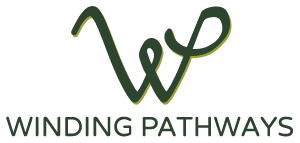by Winding Pathways | Feb 22, 2024 | Birds, Mammals, Nature, Pests
We’ve blogged before about a white-footed mouse in the house. We read the story to our kids when they were little. Time after time we snuggled down with the book and they never got tired of hearing why the mouse might be cute but doesn’t belong in the house. A recent internet search for the specific book revealed lots of stories but not the one we wanted. Alas. So, here we are decades later writing again about a mouse in the house. Mice are cute but they do not belong in a house.
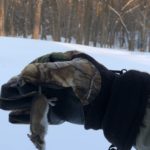
A person holding a mouse.
Whenever we’d find mouse evidence in our house, we’d set traps and usually catch a few, tossing their lifeless bodies outside for scavenger animals to eat. We do feel badly, but as the mother in the story said, “…a mouse does not belong in a house.”

Path to the outdoor pantry
In January we changed our mind…..sort of. It was 20 below zero outside. Rich trudged through snow drifts to fill our bird feeders and noticed tracks, tiny mouse tracks, in the snow. A crafty white-footed mouse had scampered on top of the snow the night before to scrounge a few leftover seeds for dinner. Its tracks led to a snug nook out of the wind and under the deck.
An average White-footed mouse weighs a whopping .7 ounce. That’s seven-tenths of an ounce! That such a tiny creature can survive the howling wind and intense cold is a marvel of nature. Every nocturnal predator from coyotes to owls tries to capture and eat this diminutive mammal. But, it is wily, wary, and quick. Although not usually out during the day, it has to be mindful of cats and hawks looking for a meal.
-
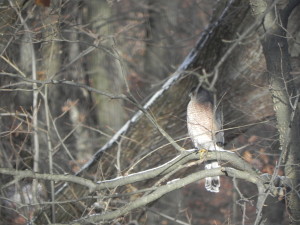
-
Patience
-
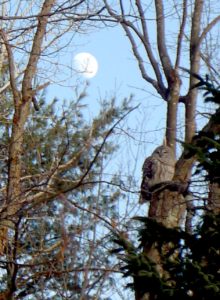
-
Nocturnal predator
After seeing those tracks, we felt a bit sorry for the animal that made them. We still won’t welcome a mouse into our house, but we’re happy it lives just outside in a safe place under the deck. He’s welcome to any seeds the birds overlooked.
To learn more about White Footed Mice and many other wild animals check out Animal Diversity Web out of the University of Michigan.
by Winding Pathways | Feb 8, 2024 | Birds, Nature
We live in a world of dizzying change in how we live, drive, and communicate. Like many people, we struggle to keep up with change and stay modern, so it’s comforting to know that some things simply don’t change. Fortunately, winter owls don’t change.
In March 1982 the Cedar Rapids GAZETTE printed Marion’s column on Iowa owls. It’s as relevant today as it was 42 years ago.
Audible In Winter
Now is the season of Winter Owls. The time of year when they are especially audible and often visible. Owls have a large vocabulary from courting to warning. YouTube is a great source to learn about and hear the sounds.
Barred and Great Horned Owls
We love hearing the clear and somewhat chilling calls of Barred and Great Horned Owls that reach our house over the snow and through the woods on clear, frosty winter nights. These two species live near our home year-round, with Barred Owls the most common. You can tell the Great Horned call that is low and throaty. The Barred calls out the familiar, “Who cooks for you?” refrain.
-

-
Waiting for supper.
-
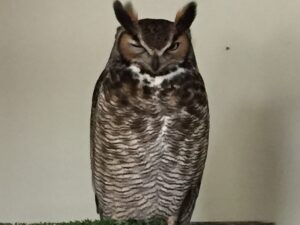
-
Injured owls find a safe home at the International Owl Center.
Screech Owls
A few times a year we drive to New Jersey to visit relatives and often are delighted to hear the two calls of a local Screech Owl serenade the evening. Its soft, haunting trill, called a tremolo, wafts over the lake. The “whinny”, think of a horse whinny, is territorial.
Northern Owls
Several of our friends trekked north this winter to see Great Grey and Northern Hawk-Owls. The Great Grey’s sound varies from a low-pitched “whoof” to an abrupt “meeh” to short screeches similar to a blue jay. The Northern Hawk Owl’s vocabulary ranges from high-pitched warbling sounds that carry across frozen landscapes to “chit-chit-chits” to a wimpy, scratchy screech. Think of a person with laryngitis trying to sing. All owls’ calls are amazing delights for those who wander outside and listen carefully on winter evenings.
-
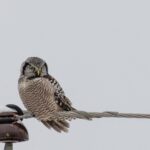
-
Northern Hawk Owl on wire. Photo Mark Ogden
-
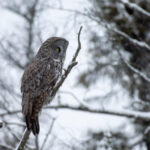
-
Great Gray Owl visits Northern Minnesota. Photo Mark Ogden
Snowy Owls
Many owl species don’t migrate much but these two sometimes dip southward from their usual winter range. So do magnificent Snowy Owls. In some especially frigid winters, they drift way south in what’s called an “irruption”. Birders flock to see them in open fields and even on the edge of airports! One of our favorite owls is the tiny Northern Saw-Whet Owl. They regularly come south in winter. Years ago, the Indian Creek Nature Center had a thick grove of young pines, a winter habitat the bird loves. Often, we could approach them closely on cold days. We even heard them once in the tiny ‘pine grove’ at our former residence.
How Do I Love Thee?
A fascinating aspect of owls is that they court and nest when it’s still winter! Although people rarely see courtship or mating, it is fascinating. Texas Backyard Wildlife captured video and the offering to the bigger female as a token of Love.
What prompts these impressive raptors to court, breed, and endure the hardships of incubating eggs in nature’s most desolate time of year? Necessity! Baby owls are a lot like human babies. They take a lot of care. For months owlets cry, eat, sleep, and poop. All the while growing. Just like humans. Young hatch late March into April when small rodents, the mainstay of owls, become more plentiful. Then, the adults really get busy foraging to feed the young tucked into nests of sticks.
Nests
Unlike some birds, Great Horned owl nests are not works of art. Adults return to the same wood tracts year after year and add only a few extra twigs. Young, like many teenagers, can make a shambles of the nest. The more practical Screech Owls prefer tree cavities and can be convinced to nest in wooden boxes adapted for them.
Parenting
During winter owls can be noisy and obvious as they wing across snowy fields at dusk. But after courtship and nesting, they quiet down. Like human adults, they are busy raising the young. By mid-summer people sometimes find “teenaged” owls flopping around on the ground or perched precariously on low branches. Like all fledglings, they are learning to fly. It’s best to leave them alone. The parent is nearby and the “kids” will make it without our help.
-
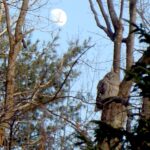
-
Waiting for supper.
-
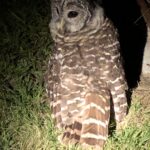
-
Grounded.
Tuck In and Read!
Winter is more than a time to hear and see owls. It’s a season to read about them. Our two favorite bird magazines featured owls in their winter 2024 editions. BIRD WATCHER’S DIGEST, features a species profile on Barn Owls. LIVING BIRD includes a fascinating article called HUNTING BY HEARING. The magazines are available online to subscribers. We enjoy both while curled up with the paper copy by the wood stove, and occasionally reading online articles. We also browse reliable internet sources and YouTube videos on owls.
Be Intrepid!
For intrepid winter visitors a trip to the International Owl Center in Houston, MN, is a delight. Their signature event, the International Festival of Owls is scheduled for March 1-3 this year.
-
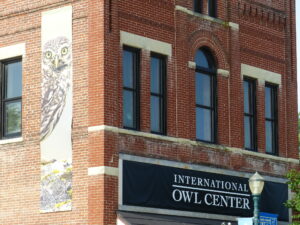
-
All things owl.
-
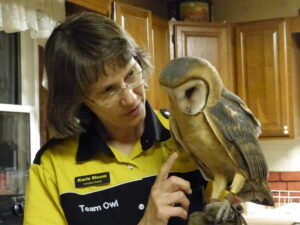
-
The International Owl Center promotes owl awareness.
Enjoy Winter
It’s winter. A season to enjoy the cold, snow, and OWLS.
by Winding Pathways | Jan 25, 2024 | Nature, Reflections/Profiles
Lots to Experience in January
(reworked from the Patterson’s “Iowa’s Wild Side” column
originally in the Cedar Rapids Gazette)
Winter in Iowa is erratic. Mild. January thaws. Grey, damp, and achy mornings. Frigid. Blustery. Sunny, sparkling days when all is right. We have it all. Here are ways we a find joy in January.
Some people escape to warmer regions. Most of us hang tough and grumble. At Winding Pathways, we’ve found that simple observations can enliven and deepen our appreciation for the change of seasons.
Sit Still
Bundled up in his Carharts and sitting quietly downwind at dusk, Rich notices deer begin to move. Stars and planets glow. Five geese honk and wing across the waxing moon. A photographer’s dream. An owl’s call fills the stillness left behind.
Wildlife freeze as the great horned owl’s ghostly shape floats silently to a branch near our home. Puffed to twice its size, a buffer against the cold, it waits. Several long minutes pass. Then, a rabbit cautiously emerges from the prairie stubble. An opossum noses hungrily at the compost heap. A startled mouse scurries across an open space. With talons extended and yellow eyes gleaming, the owl drops. After a brief scuffle, only bits of fur remain.
-
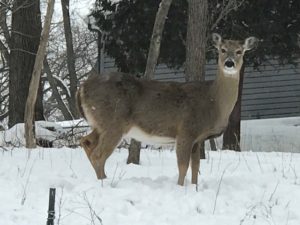
-
Inquisitive doe.
-
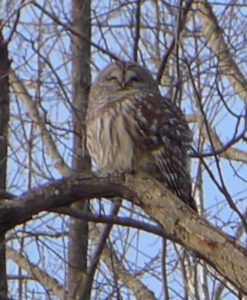
-
Waiting
-
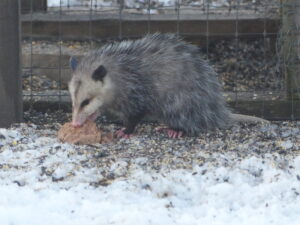
-
Possums’ feet help it climb.
Observe When You Drive
Another way we find Joy in January is by taking drives. Across a frosty Iowa road, we slow as four deer race across a field, leap a barbed wire fence, and dash to safety beyond busy Highway 30. We speculate what startled them. A short time later we observe a face-off between a grazing cow and a foraging hawk. Neck stretched out, nose to the wind, the cow eyes the hovering hawk.
From the comfort of our home, we watch birds. Siskins, when the weather is cold, Carolina wrens when winters are mild, hang around the feeder and shrubs loaded with berries. A red-headed woodpecker pecks at suet. It rattles noisily and jabs its lance-like bill at the less aggressive birds. Its strong bill is great for hammering insects out of frozen trees and pounding holes in ice-encased water baths.
January Ice
Black ice is another winter phenomenon. While not fun to drive on it is intriguing on rivers, ponds, and lakes. One Kansas winter an Arctic airmass plunged into the heartland and gave us a chance to peer into the dark depths below. A snapping turtle slowly swam through the thick water. Ice skaters reveled in the unusual event.
Nowadays we enjoy Arctic air from the inside. A small pool is just outside our window near the feeders. Sometimes, when temperatures drop quickly, and black ice forms we can see “through the looking glass” so to speak. A small aerator keeps a circle of water open. Small birds hop to the edge and drink. The overwintering goldfish appreciate the extra O2.
And we enjoy hot chocolate during January’s dormant month.
by Winding Pathways | Jan 18, 2024 | (Sub)Urban Homesteading, Birds, Nature, Pests
Frustration Yields to Creativity
Reprising the blog on thwarting House Sparrows. Here is a recap of our initial frustration and subsequent ways to encourage native birds and discourage exotics.
As we wrote earlier, hordes of House Sparrows almost made us give up feeding birds. We’d fill our feeders each morning and hope to watch juncos, cardinals, chickadees, woodpeckers, and nuthatches visit on cold winter days. Unfortunately, hordes of House Sparrows began arriving. We don’t mind feeding a few, but dozens soon devoured all the expensive seed, leaving empty feeders for native species.
Coming Up Short on “Expert Advice”
We asked bird experts what we might do to discourage House Sparrows and tried several of their ideas. Nothing worked well, so we experimented and came up with a few tricks that seem to discourage House Sparrows to a degree yet let other species eat. Our tricks aren’t perfect and sparrows still come, but not in huge numbers.
Here’s what we did:
Altered filling time:
We noticed that cardinals, jays, chickadees, and nuthatches visited feeders in the early morning and late afternoon, but House Sparrows came more late morning and toward the middle of the day. So, we put out small amounts of seeds early in the morning and again in late afternoon. Often our feeders are empty mid-day when the house sparrows prefer to visit.
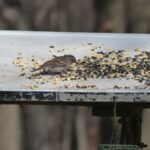
Eating from platform feeder
Sparrows enjoy feeding on the ground, on horizontal tables and other flat surfaces, and from silo-type feeders with long perches and large openings. We took down our standard silo feeders and replaced them with a silo shape feeder made of hardware cloth with a quarter-inch mesh.
In our quarter-inch mesh feeder, we put a mixture of black oil sunflower seeds and hulled peanuts. Native birds seemed better able to extract the sunflower from the mesh than House Sparrows. The peanuts don’t fit through the mesh, but many native bird species peck at them through the wire and extract pieces of peanuts. House Sparrows seem less able, or willing, to do this.
We also stopped feeding cracked corn and millet on the ground. Sparrows love them. Instead, we now toss full kernels of corn on the ground. Sparrows can’t swallow the big seeds and are unable to peck them apart. Woodpeckers, cardinals, blue jays, and nuthatches swallow or carry away the big seeds.
Put up with some House Sparrows
Our system helps deter these pesky exotic birds but is far from perfect. House Sparrows still visit and eat seeds but not as many as before we started using these tricks. Maybe they’ll work for you.
A few of you have shared. Now Others Can Share.
Winding Pathways is eager to learn other ways to deter House Sparrows. If you have discovered something that works, please let us know.
#
by Marion Patterson | Dec 21, 2023 | Nature, Pests
House Sparrow Blues
One of our favorite Thanksgiving Day activities is enjoying a sumptuous meal while watching chickadees, nuthatches, cardinals, and woodpeckers enjoy the seeds we put out for them just outside our window.
Thanksgiving 2023 brought mostly frustration. Crowds of House Sparrows swarmed our feeders with hardly a native bird in sight. Formerly known as English Sparrows, there seem to be more of these pesky immigrants every year.
Strategies
We’re not alone. A common phone call or email that comes to Winding Pathways seeks ways to feed native birds and discourage hordes of House Sparrows. Over the years we’ve tried these things to discourage the hardy and prolific Eurasian birds:
- Putting only small amounts of feed out in the early morning and late afternoon when native birds visit and House Sparrows are mostly gone.
- Cutting silo feeder perches short to make it harder for the somewhat clumsy sparrows to perch and eat.
- Sprinkle some whole corn on the lawn. It’s too big for sparrows to eat but blue jays and woodpeckers devour it.
- Sprinkle cracked corn way out in the backyard to entice sparrows away from our main feeders.
- Eliminate sparrow nesting sites around our yard and pull out any nests that form under eaves or in tight spaces along the house.
Result
None of these has worked particularly well.
Others More Fortunate
While we are frustrated, other people are fortunate. We recently enjoyed watching a procession of native birds visiting Jody Vrieze’s feeders in a rural area near Charles City, Iowa. It’s along the Cedar River and away from town. Perhaps her home and yard are a key to avoiding sparrow numbers.
-
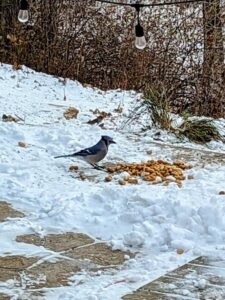
-
Jays swallow large nuts.
-
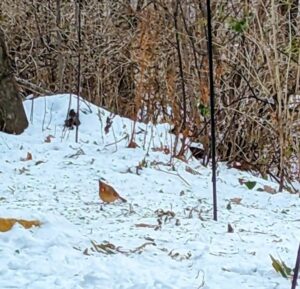
-
Cardinals enjoy eating on the ground.
-
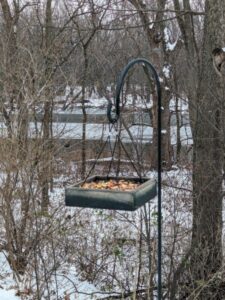
-
Woods attract native birds.
-
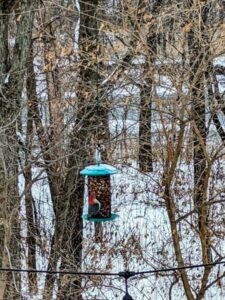
-
Many woodpeckers come to the feeders.
-
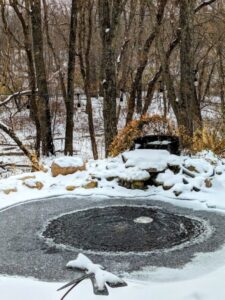
-
Open water is important for wildlife.
-
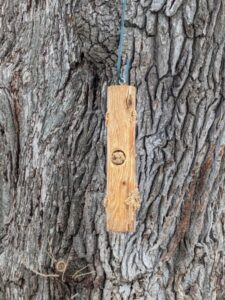
-
Peanut butter log.
What is a Synanthrope? How Do They Spread?
They are true synanthropes, meaning they need to live close to people. Backpack into a wilderness anywhere and House Sparrows are one bird that won’t be spotted. Jody’s home is in a wooded area away from town, which is probably why the pesky birds don’t visit her feeders often.
Although not liked by most birders, House Sparrows are amazing. A few were captured in Europe and released in Brooklyn, NY, in 1851. Within 50 years they had spread across the continent and are found in and near almost every town and farm. They may have peaked in numbers late in the 1800s when abundant urban horse manure provided plenty of food.
Although native to Europe and Asia, House Sparrows have spread, due to people importing them, to North and South America, Australia, New Zealand, and parts of Africa. A surefire place to not see them is Antarctica.
-
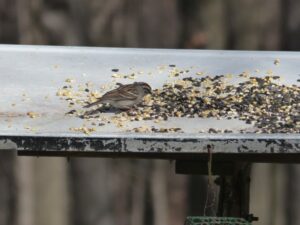
-
Eating from platform feeder
-
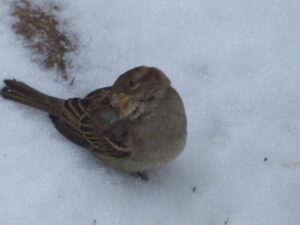
-
Thick beak of house sparrow is good for cracking corn.
Winding Pathways Asks for Help
Most people share their suburban and urban homes with plenty of House Sparrows, and moving to a wild area isn’t an option. So, what to do? Well, we listed what we do yet still have plenty of sparrows, so we’re asking for help from visitors to our Winding Pathways website. Please let us know if you’ve found a consistent and effective way to discourage this pesky bird.
Learn More
For much more information on this amazingly prolific bird go to allaboutbirds.org.
Photos by Jody Vrieze.
by Winding Pathways | Dec 14, 2023 | (Sub)Urban Homesteading, Bugs, Garden/Yard, Nature, Pests
Autumn Reveals Nature’s Wonders
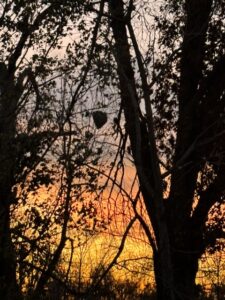
Bare trees reveal a bald-faced hornet nest.
November’s wind stripped the leaves off one of our maples and revealed a big gray football-shaped bald-faced hornet nest. Although we’d walked under it all summer, we had no clue it was there.
This fall many people will discover similar “paper wasp” nests in their trees or shrubs or even tucked near a light fixture. Made of a paper-like material, the nest was really made by insects called “bald-faced hornets” that are related to other wasps, including yellow jackets.
These social wasps can attack in droves. Their sting hurts. Because their stingers are smooth, unlike honey bees, they can sting again and again.
So, what do you do when you spot a nest on a crisp fall afternoon? Leave it alone!
Life History
The insect’s life history gives the best clue on how to avoid painful stings.
Last fall the colony of 500, or so, worker wasps died as the weather cooled. The fertile queen survived by tucking herself under a rotting log somewhere to slumber through winter. Come spring she’ll make a tiny paper-like nest, usually in a tree, and lay eggs that become workers. These hard-working new insects expand the nest and forage widely.
They are omnivores eager to dine on rotting fruit, but among their favorite foods are caterpillars and adult insects. Bald-faced hornets are a gardener’s friend, removing vegetable-chomping insects. They also sip on nectar so are good pollinators.
Aggressive or Protective?
Most sources claim they are highly aggressive, and they are if someone disturbs their nest. Several years ago, an adult neighbor spotted a nest above the doorway that the family had used all summer. He tried to knock it down and only damaged the nest. His misguided aggression unleashed an attack by dozens of upset bald-faced hornets. Stung many times, he’ll likely never again molest a nest.
We walked under and near the bald-faced hornet’s nest in our yard many times this summer and didn’t even know it was there. They didn’t attack us. Rather, they snacked on our vegetable gardens’ pests.
The lesson: leave these insects and their nest alone.
Ironically, by the time most people discover a nest in very late fall, the colony has already abandoned it. The best thing to do is NOTHING. Winter’s wind, rain, and snow will disintegrate the nest, and the queen will find a new spot to build next year’s colony.


